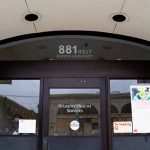Rocket manufacturing company SpaceX announced that its new giant rocket, Falcon Heavy, will launch next week — but it won’t be the only launch happening in the next few months. A micro-satellite built and designed by Boston University students is also set to launch, from a NASA base in New Zealand on April 10.
The satellite project, called ANDESITE, has been in the works for over six years in conjunction with NASA’s Educational Launch of Nanosatellites program (ELaNa), and funded by the Air Force Research Laboratory, the University Nanosatellite Program, the National Science Foundation and BU itself.
BU students from fields across engineering, physics and astronomy have been responsible for the satellite’s proposal, design and production, as well as the creation of appropriate software. The micro-satellite will measure Birkeland currents, also called “the aurora,” which are currents driven by buffeting solar winds.
Engineering professor Brian Walsh, one of the two faculty members directing the ANDESITE project, said the satellite was developed to measure small-scale features in the aurora to provide clues about the space-weather environment.
“We’ve developed a space deployer, where a bigger satellite throws out baby satellites,” Walsh said. “We’re going to be inspecting this very carefully to see how it performs, and if things go well then there’s a whole bunch of things that we can provide for the space community moving forward.”
Student Project Leader Jonathan Parham, a senior in the College of Engineering, said ANDESITE is split into two separate operations: the main body and eight smaller pico-satellites. The main body is larger, and controls radio communication with the pico-satellites.
When ANDESITE enters the atmosphere, the pico-satellites, smaller sensor nodes, will measure the specifics of the environment and send data back to ANDESITE. The satellite will in turn send the data back to Earth, where it will be read and analyzed by members of the student team.
Parham said the pico-satellites will measure activity in the magnetic field around the aurora. This data will help to determine how the aurora is formed.
“We’re flying above [the aurora] to see what the currents are and trying to figure out the structure,” Parham said. “If you’ve ever seen or looked at an aurora picture it’s all swirly and dynamic … nobody knows why exactly.”
ANDESITE is different from other satellites in that it can collect multiple data points at once, Parham said.
“It can do something that those big satellites can’t,” Parham said. “It can do that multiple point measurement. These swarms of satellites, you could never do that with a big satellite … Because it’s something no one’s ever been able to actually directly measure, it would answer a lot of questions.”
This is not the first time students have been involved in the building of a micro-satellite.
Team member Thompson Cragwell, a senior in ENG, said BU students built and launched a satellite into space once before, about 20 years ago. BU’s first micro-satellite, BUSAT, was more than four times larger than ANDESITE. The team could not find a way to launch BUSAT, and the project was shelved.
“Our group is a result of BU wanting to resurrect the program,” Cragwell said. “When I first started it was very intimidating because I wasn’t sure how I could help, but quickly found my niche and developed skills I otherwise may not have without this opportunity.”
Sergei Posnov, another team member, said he works mainly on software and hardware integration for ANDESITE, spending most of time writing the code.
“The actual things that I am doing are mostly connected to making the stuff work,” the ENG junior said. “While it’s not very hard to write the code, it’s very hard to make it integrate with the hardware.”
Team member Phillip Teng, also a junior in ENG, said students on the team are passionate about rocket technology.
“Many of my colleagues have gone on to work at SpaceX,” Teng said. “And I know that some of them will end up with jobs at NASA one day.”
Teng said that although most micro-satellites like ANDESITE fail in orbit, the team has high hopes.
“While we’ve done the most we can do in testing and verifying our nano-satellite to the best of our abilities, the possibility of failure is still very real,” Teng said. “Even if we are just able to downlink a few minutes of data, it would be a successful mission.”














